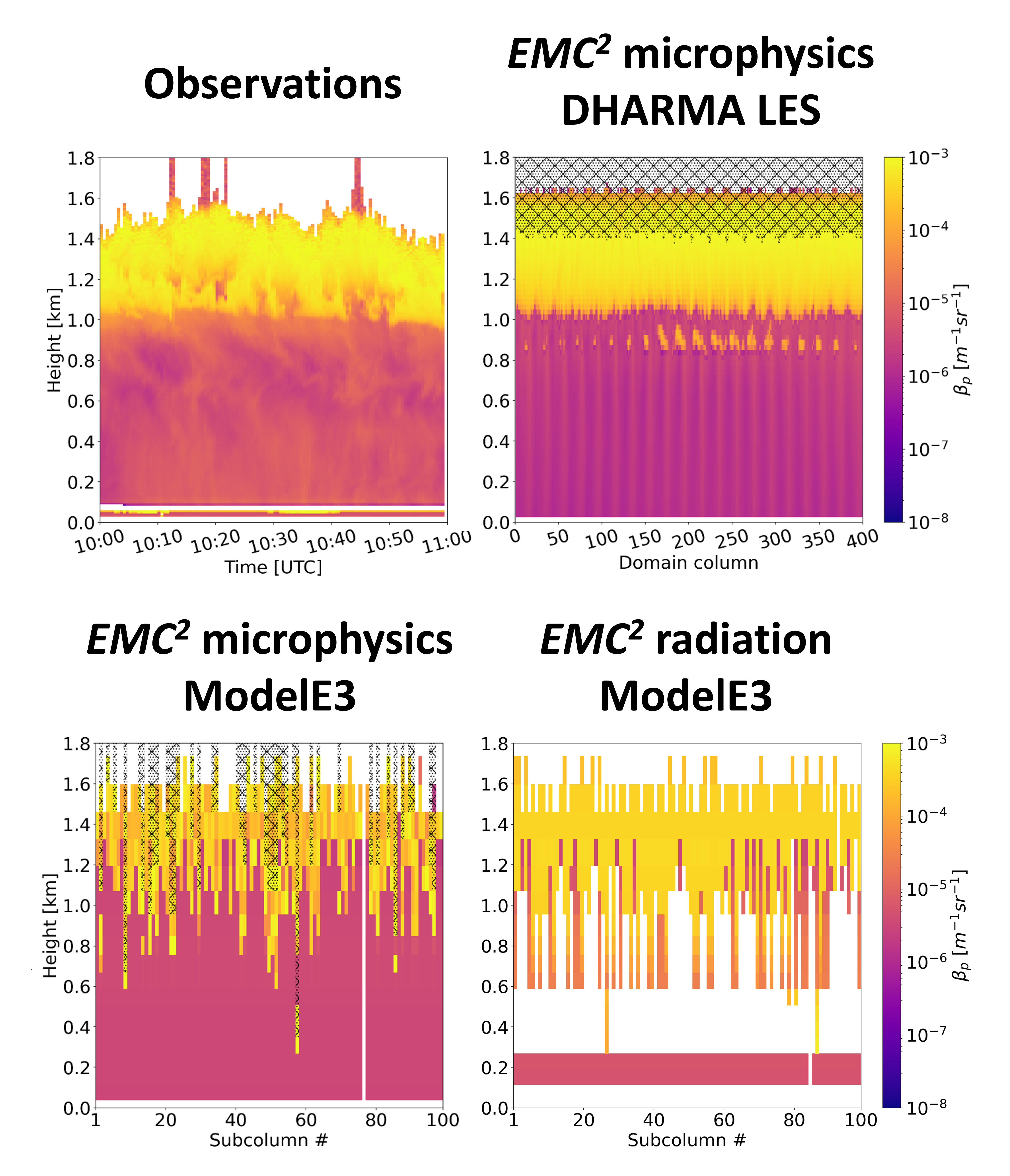The Earth Model Column Collaboratory (EMC²): An open-source instrument simulator framework
Submitter
Silber, Israel — Pacific Northwest National Laboratory
Area of Research
General Circulation and Single Column Models/Parameterizations
Journal Reference
Silber I, R Jackson, A Fridlind, A Ackerman, S Collis, J Verlinde, and J Ding. 2022. "The Earth Model Column Collaboratory (EMC2) v1.1: an open-source ground-based lidar and radar instrument simulator and subcolumn generator for large-scale models." Geoscientific Model Development, 15(2), 10.5194/gmd-15-901-2022.
Science

Figure 1. HSRL particulate backscatter cross-section (βp,tot) observed during the AWARE case study (top left; see Silber et al., JGR, 2019) and simulated with EMC² using model output from the DHARMA LES (top right) and the NASA GISS ModelE3 climate model configuration Tun3 in single-column model (SCM) mode (bottom panels). The depicted SCM output was processed with EMC² using the framework’s microphysics logic approach (bottom left) and radiation logic approach (bottom right). A mask denoting full lidar signal attenuation generated using a total accumulated optical thickness (τtot) condition of τtot > 4 is plotted over the simulated data (hatched areas). From journal.
Climate models are essential for our comprehensive understanding of Earth's atmosphere and can provide critical insights on future changes decades ahead. Because of these critical roles, today's climate models are continuously being developed and evaluated using constraining observations and measurements obtained by satellite, airborne, and ground-based instruments. Instrument simulators can provide a bridge between the measured or retrieved quantities and their sampling in models and field observations while considering instrument sensitivity limitations. We developed the Earth Model Column Collaboratory (EMC²), an open-source, ground-based lidar and radar instrument simulator and sub-column generator, specifically designed for large-scale models, in particular climate models, but also applicable to high-resolution model output.
Impact
EMC² provides a flexible framework enabling direct comparison of model output with ground-based observations, including the generation of sub-columns that may statistically represent finer model spatial resolutions. In addition, EMC² emulates ground-based (and air- or space-borne) measurements while remaining faithful to large-scale models' physical assumptions implemented in their cloud or radiation schemes. The latest version of EMC² (v. 1.2; available on GitHub: https://github.com/columncolab/EMC2, conda-forge: https://anaconda.org/conda-forge/emc2, and PyPI: https://pypi.org/project/emc2/) already incorporates physical assumptions implemented in the NASA GISS ModelE3, E3SM, and CESM2 ESMs, supports the WRF model, and includes instrument modules for all of ARM’s radar and lidar instruments.
Summary
EMC²’s instrument simulator uses either single-particle or bulk-particle size distribution lookup tables, depending on the selected scheme approach, to perform the forward calculations. To facilitate model evaluation, EMC² also includes three hydrometeor classification methods, namely, radar- and sounding-based cloud and precipitation detection and classification, lidar-based phase classification, and a Cloud Feedback Model Intercomparison Project Observational Simulator Package (COSP) lidar simulator emulator. The software is written in Python, is easy to use, and can be straightforwardly customized for different models, radars, and lidars. In the recently published GMD manuscript, we describe the framework’s logic, functionality, features, and software structure of EMC², followed by a case study example of a highly supercooled mixed-phase cloud based on measurements from the U.S. Department of Energy Atmospheric Radiation Measurement (ARM) user facility's West Antarctic Radiation Experiment (AWARE) (see figure below). We compare observations with the application of EMC² to outputs from four configurations of the NASA Goddard Institute for Space Studies (GISS) climate model (ModelE3) in single-column model (SCM) mode and from a large-eddy simulation (LES) model. As briefly demonstrated in the manuscript, EMC² can provide a lightweight and flexible framework for comparing the results of both large-scale and high-resolution models directly with observations, with relatively little overhead and multiple options for achieving consistency with model microphysical or radiation scheme physics.
Keep up with the Atmospheric Observer
Updates on ARM news, events, and opportunities delivered to your inbox
ARM User Profile
ARM welcomes users from all institutions and nations. A free ARM user account is needed to access ARM data.


















